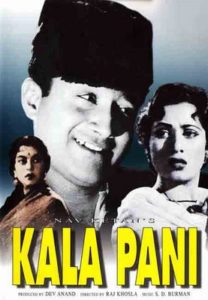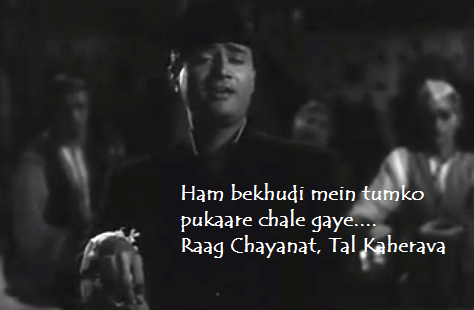Raaga Based Song of the Day: Ham bekhudi mein tumko pukaare chale gaye…
Raag Chayanat, Tal Kaherava
We have completed thirty days of Raaga Based Songs of the Day. Our first post in the series was titled ‘Raaga Based Song Of The Day #1’ and the song was a Mohammad Rafi and Lata Mangeshkar song from the 1970 Shakti Samanta movie Pagla Kahin Ka: Tum mujhe youn bhula na paoge. It is in Raag Jhinjhoti, Tal Kaherava.
Our thirtieth post was titled ‘Raaga Based Song Of The Day #30’ and the song was a Lata Mangeshkar song from the 1960 Hrishikesh Mukherjee movie Anuradha: Haay re vo din kyun naa aaye. It is in Raag Janasammohini, Tal Rupaktal.
This blog has a number of posts on Raaga based songs in Hindi movies titled similarly; for example: ‘The Best Raaga Based Songs in Hindi Movies – Raaga Yaman – Part III’.
In the last thirty days of sharing Raaga based songs of the day, I have given you songs based on Raag Jhinjhoti, Gara, Bhimpalasi, Madhuvanti, Shivaranjani, Bihag, Pahadi, Sarang, Pilu, Bhairavi, Khammaj, Charukesi, Kalyan or Yaman, Desh, Malgunji, Kirwani, Kedar, Bageshri, Megh Malhar, Bhupali, Ahir Bhairav, Malkaush, Adana, Kafi, Rageshri, Jaunpuri, Tilang and Janasammohini.
Today, I give you a song in Raag Chayanat, Tal Kaherava.
However, first, lets take up the value added learning of today. Today, we shall learn about Khayal:
Khayal is a modern genre’ of Hindustani Music; it certainly came after Dhrupad that I have told you about. The Urdu word Khayal means ‘Imagination’ and hence this flexible form of music uses a lot of improvisations.
A Khayal song is normally called a bandish (composition). Generally, in a performance there would be number of short (2 to 8 lines) songs, with each singer rendering the same bandish differently; in which the lyrics and raaga remains the same. These compositions are in Urdu/Hindi/Hindustani/Punjabi or combinations. The themes that the compositions cover include love (both romantic and divine), Krishna-Leela, praise of gods, kings, seasons and times of day.
The Khayal bandish is divided into two parts — the sthayi (or asthayi) and the antara, with the former considered more important as it shows the melodic contours of the raga. The sthayi often uses notes from the lower octave and the lower half of the middle octave, while the antara ascends to the tonic of the upper octave and beyond before descending and linking back to the sthayi.
The main facet of Khayal, as I told you, is improvisation. Each singer uses the bandish as a base for improvisation. The singer is normally accompanied by harmonium, sarangi or violin, and a tabla. The instruments play off the singer’s melody line and these instruments play this even when the singer pauses for breath. Thus, continuity is maintained. The accompanying Tal are generally Ektal, Jhaptal, Tintal, Rupaktal, Jhaptal and Tilwada.
A typical khayal performance uses two songs — the bada khayal or great khayal, in slow tempo (vilambit laya), comprises most of the performance, while the chhota khayal (small khayal), in fast tempo (drut laya), is used as a finale and is usually in the same raga but a different taal.
As I mentioned, today’s song is composed in Raag Chayanat, Taal Kaherava.
Raag Chayanat or Chhayanat belongs to the Kalyan Thaat to be sung during the second prahar of the night (9 PM to midnight). Its Jati is Shadhav-Sampoorna (six notes in Aaroha and seven notes in Avaroha).
Raag Chayanat is related to the now obscure raaga Nat.
Chayanat, Gaud Sarang, Kedar and Kamod raagas have similar tone material and share similar melodic movements as well. It requires a clear conception of their individual melodic features to avoid drifting from one raaga to another.
The other songs composed in Raag Chayanat are:
| 1. 2. 3. 4. 5. 6. 7. 8. 9. 10. 11. 12. 13. 14. 15. 16. 17. 18. 19. 20. |
Chanda Re Ja Re Sab Kuchh Luta ke Hum Bekhudi Me Dil Gham Se Jal Raha Tere Naina Talaash Keren Baad Muddat Ke Lagta Nahin Hai Dil Itni Haseen Itni Zindagi Kitni Khoobsurat Aaj Bichhde Hain Fir teri Yaad Naye Gham Aap Aaye Gharib Kahen Me Sher Ka Husn Ho Paas Ho Tum Magar Wo Chal Diye Hain Meri Nigaah Ne Kya Tumhi Kaho mera Man Jhuka Jhuka Ke Nigahen Mujhse Naaraz Ho To Tum Meri Zindagi Me |
Ziddi Ek Saal Kala Pani Shama Talaash Jahan Aara Laal Quila Nartaki Bin Badal Barsaat Thodi Si Bewafai Aayi Teri Yaad Sitaara Chambal Ki Qasam Lootmaar Gulnaar Mohabbat Isko Kehten Hain Girls School Miss Coca Cola Papa Kehten Hain Bombay To Goa |
Lata Lata & Talat Rafi Suman Manna Dey Rafi, Suman Rafi Mahendra Hemanti, Lata Bhupinder Bhupinder Asha Rafi Lata Noor Jahan Rafi Lata Mukesh, Asha Sonu Nigam Lata, Kishore Kumar |
 I have taken the song from 1958 production of Dev Anand for Navketan Films that was directed by Raj Khosla: Kala Pani. The movie starred Dev Anand as Karan trying to prove the innocence of his father Shankarlal who was, through deceit, put in a jail. To unearth the truth, he must take the help of a courtesan Kishori played by Nalini Jaywant. Meanwhile he hires a room in the house of Asha (Madhubala) and sure enough they fall in love.
I have taken the song from 1958 production of Dev Anand for Navketan Films that was directed by Raj Khosla: Kala Pani. The movie starred Dev Anand as Karan trying to prove the innocence of his father Shankarlal who was, through deceit, put in a jail. To unearth the truth, he must take the help of a courtesan Kishori played by Nalini Jaywant. Meanwhile he hires a room in the house of Asha (Madhubala) and sure enough they fall in love.
This plot led to several very enchanting songs penned by Majrooh Sultanpuri and composed by SD Burman, who was, by now, music director of choice for Dev Anand movies.
Hum bekhudi mein was, in the movie, penned by shayars with whom Karan (Dev Anand) was staying in Asha’s house and Dev Anand used the song to woo Kishori (Nalini Jaywant).
Please enjoy in Raag Chayanat, Tal Kaherava: Ham bekhudi mein tumko pukaare chale gaye…
Ham… aa… chale gaye
ham bekhudii me.n tumako pukaare chale gaye
ham…
ham bekhudii me.n tumako pukaare chale gaye
saaGar me.n zindagI ko utaare chale gaye
ham…
Dekhaa kiye tumhe.n ham, banake diivaanA – 2
utaraa jo nashaa to, hamane ye jaanaa
saare vo zindagI ke sahaare chale gaye
ham bekhudii me.n tumako pukaare chale gaye
ham…
Tum to naa kaho ham, khud hii se khele – 2
Duube nahii.n ham hii yuu.N, nashe me.n akele
shiishe me.n aapako bhii utaare chale gaye
ham bekhudii me.n tumako pukaare chale gaye
saagar me.n zindagI ko utaare chale gaye
ham…
We have intended to learn about Raaga based music whilst we entertain ourselves with Raaga based songs. So, lets, once again, take stock of our collective learning so far:
- On the first day we learnt about the Raaga system devised by Pandit Vishnu Narayan Bhatkhande, which is the prevalent system in Hindustani Classical Music and based on ten Thaats.
- On the second day we learnt about Tal or Taal.
- On the third day we learnt about characteristics of Raagas that included Swar, Jati, Thaat, Arohana and Avarohana, Vadi, Samvadi and Pakad.
- On the fourth day, we learnt about Sargam.
- On the fifth day, we learnt about notations used in Indian classical music or simply Swar Lipi.
- On the sixth day, we learnt about the Ras (sentiments) that Raagas evoke.
- On the seventh day, we learnt about various types of Swar: Shuddha, Achal, Vikrut, Komal and Teevra.
- On the eighth day, we learnt the parts of a composition in Indian Classical Music.
- On the ninth day, we learnt the names of some of the popular instruments used in Indian Classical Music.
- On the tenth day, we learnt about the sources of names of Raagas.
- On the eleventh day, we learnt about why Bhairavi is the first raag to be taught to beginners and also why it is the last in a performance.
- On the twelfth day, we learnt about Khammaj Thaat.
- On the thirteenth day, we learnt about Tal Punjabi Theka or Sitarkhani.
- On the fourteenth day, we learnt about Alap.
- On the fifteenth day, we learnt about List of Raagas (Raagmala) in my favourite book: Sri Guru Granth Sahib.
- On the sixteenth day, we learnt about tips for raaga identification.
- On the seventeenth day, we learnt the basics of Gharana system.
- On the eighteenth day, we learnt about Filmi Sangeet.
- On the nineteenth day, we learnt about the commonest Tal in Raagas: Tintal.
- On the twentieth day, we learnt about the Kafi Thaat.
- On the twenty-first day, we learnt a little more in detail about the classification of Raagas.
- On the twenty-second day, we learnt the essential differences between Bhairavi and Bhairav.
- On the twenty-third day, we learnt a little more in detail about the Jati or Jaati of a raaga.
- On the twenty-fourth day, we learnt details of Thaat Bilawal, the most basic thaat in the Bhatkhande’s system of raagas.
- On the twenty-fifth day, we learnt about Tintal.
- On the twenty-sixth day, we learnt in detail about the Raaga – Samay linkage.
- On the twenty-seventh day, we learnt about Lehar.
- On the twenty-eighth day, we learnt about the history of the Hindustani Music.
- On the twenty-ninth day, we learnt about Dhrupad.
- On the thirtieth day, we learnt about Rupaktal that I was introduced to, a few months back, by my friend Anand Desai.
- And today, on the thirty-first day, we learnt about Khayal.
There is much more still to be learnt and enjoyed.
Please stay tuned!

Unadulterated wealth of info you have given us. Fantastic Ravibhai
Thank you Anand